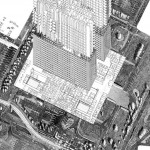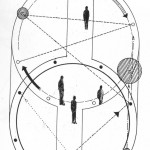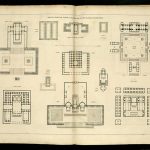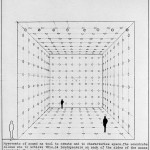Recently my work with color has led me, in spite of myself, to search little by little, with some assistance (from the observer, from the translator), for the realization of matter, and I have decided to end the battle. My paintings are now invisible and I would like to show them in a clear and positive manner, in my next Parisian exhibition at Iris Clert’s.
(Stich, Sidra. Yves Klein. Hayward Gallery. London, 1994.)
On April 28, 1958, French artist Yves Klein opened his first -landmark- exhibition at the Iris Clert Gallery in Paris. The show, called La spécialisation de la sensibilité à l’état matière première en sensibilité picturale stabilisée, Le Vide (The Specialization of Sensibility in the Raw Material State into Stabilized Pictorial Sensibility, The Void), took place in a less than 20sqm gallery completely emptied of objects: all items were removed from the gallery space apart from a display case and all walls were painted white by the artist himself during a 48 hours isolation.




In the opening night, on his 30th birthday, the artist set up a sophisticated entrance ceremony: blue drapery was hung in the lobby of the building (the only entrance to the gallery left after the main gallery’s door was shut), the gallery’s window was painted blue, two Republican Guards surveilled the access and two further bodyguards were meant to guard the Guards. A blue drink (a combination of gin, Cointreau, and methylene blue) was served to the 3500 attendees, who apparently ended up urinating blue the next day (much to the artist’s delight).

The invitations were printed on small postcards, with a monochrome blue stamp, and anticipated the participatory nature of the happening, in which the public act was turned into a valid conceptual artwork.

The show was a huge success, hailed by the likes of writer Albert Camus (“With the void, full empowerment.”) and art critic Jean Grenier, who wrote that “The Void” represented “the numerous magic and incalculable powers given in a single color.”
Between 1958 and 1969 Iris Clert held three more exhibitions of Yves Klein, but the relationship between the artist and the gallerist was severed abruptly after a dispute over intellectual rights.
However, in October 1960, Arman, a French artist who was a close friend with Klein, exhibited in the same gallery a show called Le Plein (The Full-Up). This exhibition was a direct contradiction of Klein’s Void: a huge amount of garbage filled the small rooms, so much that it could only be seen from the storefront window. The invitations were sent on simple sardine cans on top of which it was printed “Arman – Le Plein – Iris Clert”. Despite the relationship between Klein and Clert was officially over, the artist appreciated Arman’s show and declared: “After my own emptiness comes Arman’s fullness. The universal memory of art was lacking his conclusive mummification of quantification.”



Read more:
Nuit Banai, “Rayonnement and the Readymade: Yves Klein and the End of Painting” in Res Anthropology and Aesthetics, Volume 51, Spring 2007.





Leave a Reply